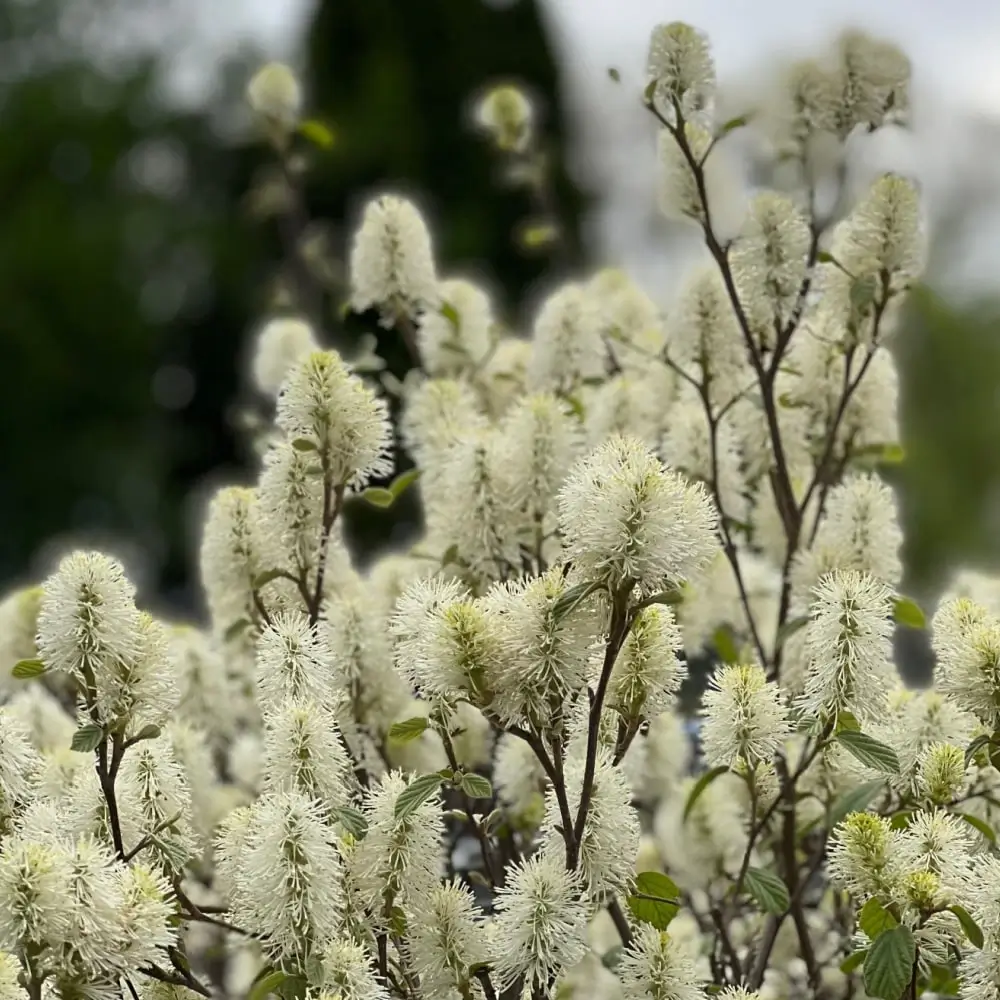Family: Fothergilla
Type: Shrub
Other Common Name: Witch Alder

Dwarf Fothergilla, or Fothergilla gardenii, is a charming, compact shrub known for its seasonal interest and easy care. It’s an excellent choice for small gardens and mixed borders.
This plant is renowned for its fragrant, bottlebrush-like white flowers in spring. The blooms appear before the foliage, offering a delightful display against the bare branches.
In fall, Dwarf Fothergilla showcases stunning foliage in shades of yellow, orange, and red. This shrub provides year-round interest with its seasonal color changes and attractive, slow-growing habit.
Hardiness Zone: 5a-5a
Pet Friendly: Yes
Moisture Preference: Moist
Sun Needs: Full sun to partial shade
Growth Rate: Slow
Average Height (feet): 3
Average Spread (feet): 3
Average Life Span (years): 40
Form: Round
Flower Color: White
Bloom Season: In mid spring
Foliage Color: Green
Leaf Fall Color: Orange
Foliage Shape: Round
Bark Color: Brown
Bark Texture: Smooth
Incorporating Dwarf Fothergilla into your landscape brings multi-seasonal interest. Its compact size makes it ideal for various garden spaces without overwhelming them.
This shrub works beautifully as a specimen plant or in mixed shrub borders. Its vibrant fall color and spring blooms make it a standout in any garden.
Dwarf Fothergilla is also great for foundation plantings and small hedges. Its neat growth habit and attractive foliage create a tidy, appealing look.

In woodland gardens, Dwarf Fothergilla fits naturally. Its preference for dappled shade and organic-rich soil complements the understory of a wooded area.
Dwarf Fothergilla adds charm to cottage gardens. Its spring flowers and colorful fall foliage blend seamlessly with the informal, lush style of cottage planting.
This shrub can also enhance formal garden designs. Its symmetrical growth and seasonal changes add interest and structure to formal garden layouts.
Plant alongside spring bulbs. The early blooms of Dwarf Fothergilla complement spring-flowering bulbs, extending the garden’s interest.
Use in a native plant garden. Being a native plant, it supports local wildlife and fits perfectly into naturalistic garden designs.
Combine with evergreens for contrast. The changing colors of Dwarf Fothergilla contrast beautifully with the constant green of evergreens.
Select our pre-made garden layouts to create a landscape that’s uniquely yours. Simple, smart, and customizable!
In spring, Dwarf Fothergilla bursts into life with fragrant, white flowers. The blooms stand out on the still-bare branches, heralding the start of the growing season.
During summer, the shrub is covered in deep green leaves, offering a lush, full appearance. It provides a steady, green backdrop for other garden plants.
Fall is when Dwarf Fothergilla truly shines. Its leaves turn to vibrant shades of yellow, orange, and red, creating a spectacular autumn display.
In winter, after the leaves have fallen, Dwarf Fothergilla's branching structure adds architectural interest to the garden. Its compact form remains attractive, even in dormancy.
Dwarf Fothergilla thrives in a location with full sun to partial shade. It prefers morning sun with some afternoon shade, especially in hotter climates.
This shrub does best with a mix of sun and shade. Full sun encourages more vibrant fall colors, but too much direct sun can stress the plant in hot climates.
Dwarf Fothergilla prefers acidic, well-draining soil rich in organic matter. It can tolerate a range of soil types, including clay, as long as the drainage is good.
Space Dwarf Fothergilla plants about 3 to 5 feet apart. This spacing allows for their growth over time and ensures proper air circulation around each plant.
The best time to plant Dwarf Fothergilla is in the spring or early fall. Planting in cooler weather allows the shrub to establish its roots without the stress of high summer temperatures.
Dig a hole as deep as the root ball and twice as wide. Place the shrub in the hole, fill it with soil, and water thoroughly. Adding organic mulch can help retain moisture and regulate soil temperature.
Water regularly, especially during the first growing season to establish a deep, extensive root system. Once established, Dwarf Fothergilla is somewhat drought-tolerant but prefers consistent moisture.
Apply a balanced, slow-release fertilizer in early spring. Avoid over-fertilizing, which can harm the plant and reduce its flowering and fall color.
Pruning is rarely needed but can be done to shape the plant or remove any dead or diseased branches. The best time for pruning is late winter or early spring before new growth starts.
In spring, remove any winter mulch and apply a balanced fertilizer. Monitor for new growth and water as needed to encourage healthy development.
During summer, keep the soil consistently moist, especially in dry conditions. Dwarf Fothergilla requires little care during the summer months.
In fall, prepare the plant for winter. Reduce watering as the plant goes dormant, and apply a layer of mulch to protect the roots in colder climates.
Dwarf Fothergilla requires minimal care in winter. In colder regions, ensure it is well-mulched. The shrub is generally hardy and doesn't need winter protection in most climates.
Dwarf Fothergilla typically grows to about 3 to 4 feet in height and width, making it suitable for small to medium-sized garden spaces.
Yes, Dwarf Fothergilla is generally considered deer resistant. It’s a good choice for gardens in areas with high deer populations.
While not a traditional hedge plant, Dwarf Fothergilla can be used for informal, low hedges or borders due to its compact size and attractive foliage.
Sign up below to get exclusive deals, discounts, and new plant collections—delivered straight to your inbox! Plus, stay inspired with the latest gardening tips, landscaping trends, and DIY garden ideas. Start growing with us today!
A big thank you for subscribing to the PBN Design newsletter.
We're thrilled to have you join our community. Get ready for exciting updates, insightful content, and more delivered straight to your inbox.
Stay tuned!
Go backA big thank you for subscribing to the PBN Design newsletter.
We're thrilled to have you join our community. Get ready for exciting updates, insightful content, and more delivered straight to your inbox.
Stay tuned!
Go back